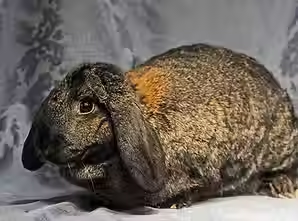
Not all rabbits outdoors are wild - many are lost or abandoned pets in urgent need of help. Learn how to tell the difference.
Report a suspected stray rabbit. Together, we can give them the safe, loving homes they deserve.

FOUND A RABBIT OUTDOORS?
HERE'S HOW TO TELL IF HE IS A LOST PET
Rocky Mountain House Rabbit Rescue (RMHRR) frequently hears from kind-hearted individuals who spot rabbits outside and want to help. While we deeply appreciate the concern, it’s important to know the difference between wild cottontails and domestic house rabbits, as RMHRR only rescues and rehabilitates domestic rabbits.
We do not respond to reports of wild cottontails.
EXAMPLES OF WILD COTTONTAIL RABBITS



How to Identify a Wild Cottontail:
-
Always small—typically 2–3 pounds
-
Uniform brown (agouti) coat
-
Upright ears and a white underside on the tail
-
Long, thin legs and a lean body
-
Extremely alert and quick to flee
Found an injured wild rabbit? Contact Greenwood Wildlife Rehabilitation Center at (303) 823-8455
or reach out to Colorado Parks and Wildlife.
EXAMPLES OF DOMESTIC HOUSE RABBITS

.avif)
.avif)
How to Identify a Domestic House Rabbit:
-
Can range from 2-pound dwarfs to 12–16-pound breeds like Flemish Giants
-
Come in a variety of coat colors, lengths, and patterns (not just brown)
-
May have upright ears or floppy ears ("lops")
-
Rounder, fuller body shape compared to wild rabbits
-
Often more approachable or less fearful, though not always
Still unsure? Read more here.
FOUND A RABBIT NEST?
Leave the Nest Alone!
Found a rabbit nest? Don’t disturb it.
If you’ve already moved the babies, put them back—mom won’t abandon them. Then wash your hands.
Mother rabbits stay away from the nest to avoid attracting predators. She visits briefly, usually at night, so you probably won’t see her.
Most baby bunnies found outside are wild cottontails. If the nest is
destroyed or scattered, contact a licensed rehabilitator:
-
Kathy (Larkspur): 303-726-7897
Before calling, note:
-
Are they covered in fur?
-
Are their eyes open?
-
Size (fit in palm or whole hand?)
-
Don’t handle them—cottontails can carry Tularemia.
-
Unsure if mom is around?
Place two sticks in an "X" over the nest. If moved by morning, mom is caring for them. If not, call a rehabilitator.
Nest destroyed?
Place babies in a box with soft cloth, dry grass/hay, and any fur you find. Keep them warm, dry, and quiet until help arrives.
FOUND A DOMESTIC RABBIT OUTDOORS?
If you think you’ve spotted an abandoned or stray house rabbit, please don’t wait—your report could save his life.
Domestic rabbits can’t survive outdoors. If you're fairly sure the rabbit is not wild, fill out the form below with location details and a photo. If you’re unsure, just send a picture—we’ll help identify it.
Our Bunny Brigade is trained to safely capture stray rabbits and will do everything we can to assist.
Please act quickly—your report may be this rabbit’s only chance.
Limited Intake Capacity
Due to a high volume of stray rabbit reports, our ability to take in new strays is currently very limited. While RMHRR cannot guarantee intake, we can assist with capturing loose rabbits and provide alternative placement options.
Thank you for your understanding and compassion.


